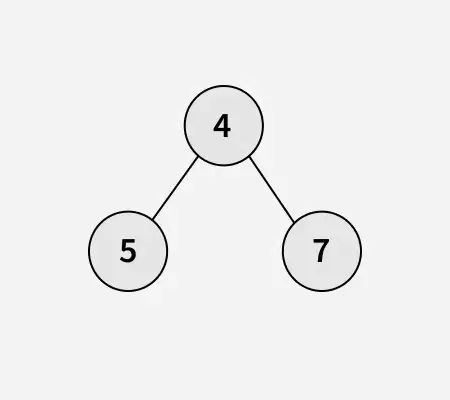Враховуючи ан n-не дерево містить додатні значення вузлів, завдання полягає в тому, щоб знайти глибина дерева.
Примітка: Ан n-не дерево це дерево, де кожен вузол може мати нуль або більше дитячі вузли. На відміну від бінарного дерева, яке має не більше двох дітей на вузол (ліворуч і праворуч) n-ічне дерево дозволяє кілька гілок або дітей для кожного вузла.
приклади:
введення:
Вихід: 3
Пояснення: Найдовший шлях від кореня (вузол 81) до аркуша становить 81 -> 26 -> 95 або 81 -> 26 -> 86, що дає максимальну глибину 3.введення:

Вихід: 2
Пояснення: Найдовший шлях від кореня (вузол 4) до будь-якого листка (вузли 5 або 7) дорівнює 2, оскільки він вимагає лише двох рівнів обходу.реєструвати пам'ять
Підхід:
Ідея полягає в тому, щоб обчислити глибина N-арного дерева рекурсивно ініціалізувати максимальна глибина як 0, потім рекурсивно обчислити глибина для кожної дитини та стежити за найвища глибина зіткнувся. Нарешті додати 1 на максимальну глибину (для поточного вузла) і повернути результат . Цей підхід гарантує, що ми знайдемо найдовший шлях від кореня до будь-якого листкового вузла.
Дерево N-Ary можна обійти так само, як і звичайне дерево. Нам просто потрібно розглянути всіх нащадків певного вузла і рекурсивно викликати цю функцію на кожному вузлі.
C++// C++ Code to find the depth of an N-ary tree #include
// Java Code to find the depth of an N-ary tree import java.util.*; class Node { int data; List<Node> children; Node(int val) { data = val; children = new ArrayList<>(); } } // Recursive function to calculate // maximum depth class GfG { static int maxDepth(Node root) { // If the node is null depth is 0 if (root == null) { return 0; } int depth = 0; // Recur for all children and find // the maximum depth for (Node child : root.children) { depth = Math.max(depth maxDepth(child)); } // Add 1 to include the current node // in the depth count return depth + 1; } public static void main(String[] args) { // Representation of given N-ary tree // 1 // / | // 2 3 4 // / // 5 6 Node root = new Node(1); root.children.add(new Node(2)); root.children.add(new Node(3)); root.children.add(new Node(4)); root.children.get(0).children.add(new Node(5)); root.children.get(2).children.add(new Node(6)); System.out.println(maxDepth(root)); } }
# Python Code to find the depth # of an N-ary tree class Node: def __init__(self val): self.data = val self.children = [] # Recursive function to calculate # maximum depth def max_depth(root): # If the node is None depth is 0 if not root: return 0 depth = 0 # Recur for all children and # find the maximum depth for child in root.children: depth = max(depth max_depth(child)) # Add 1 to include the current # node in the depth count return depth + 1 if __name__ == '__main__': # Representation of given N-ary tree # 1 # / | # 2 3 4 # / # 5 6 root = Node(1) root.children.append(Node(2)) root.children.append(Node(3)) root.children.append(Node(4)) root.children[0].children.append(Node(5)) root.children[2].children.append(Node(6)) print(max_depth(root))
// C# Code to find the depth of an N-ary tree using System; using System.Collections.Generic; class Node { public int data; public List<Node> children; public Node(int val) { data = val; children = new List<Node>(); } } // Recursive function to calculate // maximum depth class GfG { static int MaxDepth(Node root) { // If the node is null depth is 0 if (root == null) { return 0; } int depth = 0; // Recur for all children and find the maximum depth foreach (Node child in root.children) { depth = Math.Max(depth MaxDepth(child)); } // Add 1 to include the current // node in the depth count return depth + 1; } static void Main(string[] args) { // Representation of given N-ary tree // 1 // / | // 2 3 4 // / // 5 6 Node root = new Node(1); root.children.Add(new Node(2)); root.children.Add(new Node(3)); root.children.Add(new Node(4)); root.children[0].children.Add(new Node(5)); root.children[2].children.Add(new Node(6)); Console.WriteLine(MaxDepth(root)); } }
// JavaScript Code to find the depth // of an N-ary tree class Node { constructor(val) { this.data = val; this.children = []; } } // Recursive function to calculate // maximum depth function maxDepth(root) { // If the node is null depth is 0 if (!root) { return 0; } let depth = 0; // Recur for all children and find // the maximum depth for (let child of root.children) { depth = Math.max(depth maxDepth(child)); } // Add 1 to include the current node // in the depth count return depth + 1; } // Representation of given N-ary tree // 1 // / | // 2 3 4 // / // 5 6 const root = new Node(1); root.children.push(new Node(2)); root.children.push(new Node(3)); root.children.push(new Node(4)); root.children[0].children.push(new Node(5)); root.children[2].children.push(new Node(6)); console.log(maxDepth(root));
Вихід
3
Часова складність: O(n), оскільки кожен вузол відвідується один раз, де n — загальна кількість вузлів у N-арному дереві.
Допоміжний простір: O(h), де h — висота дерева через рекурсивне використання стека викликів.


